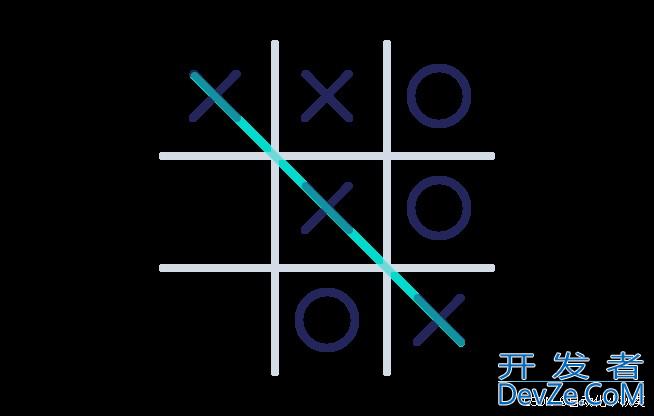Python入门经典题目实战应用指南
目录
- 列表与元组
- 面向对象编程题目
- 1.石头剪刀布
- 2.井字游戏
- 棋盘类
- 玩家类
- 游戏类
- 总结
利用python处理一些小问题,主要学习此过程中语言如何应用,与c/cpp不同的地方。
列表与元组
给定一个联系人列表,每个联系人用一个元组表示,其中有联系人的姓名name和年龄age。
编写该程序,输入一个字符串,在联系人列表中搜索该人名,并以示例格式输出该联系人的年龄。
没找到联系人输出Not Found
contacts = [
('James', 42),
('Amy', 24),
('John', 31),
('Amanda', 63),
('Bob', 18)
]
name = input()
notfound = True
for x in contacts:
if(x[0] == name):
print(f"{name} is {x[1]}")
notfound = False
if notfound:
print("Not Found")
1.元组是有序的(1,2,3),集合是无序的{1,2,3}
2.在列表中的元组,for x in contacts,是一个元组一个元组遍历,而元组x[0],x[1]分别表示元组中第几个元素(有序的)
3.输出表示:print(f"{name} is {x[1]}")
面向对象编程题目
1.石头剪刀布
#电脑随机生成数字
import random
class Game():
#我们通过类里面的方法获得类的属性值
def __init__(self):
self.computer_pick = self.get_computer_pick()
self.user_pick = self.get_user_pick()
self.result = self.get_result()
#电脑随机生成选项 def get_computer_pick(self):
random_num = random.randint(1,3)
options = {1:"paper",2:"scissors",3:"rock"}
return options[random_num]
#用户输入获取
def get_user_pick(self):
while True:
user_pick = input('输入石头/剪子/布:')
user_pick = user_pick.lower()
if user_pick in ("paper","scissors","rock"):
break
php else:
print('error input!')
return user_pick
#判断胜负
def get_result(self):
if self.computer_pick == self.user_pick:
result = '平局'
elif self.user_pick =='paper' and self.computer_pick == 'rock':
result = '获胜'
elif self.user_pick =='rock' and self.computer_pick == 'scissors':
result = '获胜'
elif self.user_pick =='scissors' and self.computer_pick == 'paper':
result = '获胜'
else:
result = '失败'
return result
#打印情况
def print_result(self):
print(f"Computer's pick: {self.computer_pick}")
print(f'Your pick: {self.user_pick}')
print(f'You {self.result}')
# 运行
if __name__ == '__main__':
game = Game()
game.编程客栈print_result()
1.我第一次写的时候(刚学完类)将方法前面的self遗漏了,导致报错,代码会找全局函数get_computer_pick(),所以类里面的方法和属性需要加self哦!
2.之所以不需要调用game.get_user_pick(),game.get_computer_pick()和game.get_result()是因为把这些方法调用写入了__init__(),创建对象的时候自动调用了,只需要给输入即可打印情况!
3.其次可以学习一下利用随机模块random和字典生成不同选项的用法
#电脑随机生成选项
def get_computer_pick(self):
random_num = random.randint(1,3)
options = {1:"paper",2:"scissors",3:"rock"}
return options[random_num]
-------------------------------------------------------
def get_computer_pick():
options = ('rock', 'paper', 'scissors')
return random.choice(options)
4.学习一下用户输入获取正确的方法
5.学一下用类构建这类游戏的思维(函数也能构建)
2.井字游戏
在这个项目中,我们将用Python创建一个井字形游戏。

我们将使用面向对象的编程来创建这个游戏。我们的游戏将有三个类:
- 棋盘:处理井字棋盘并处理获胜/抽签逻辑
- 玩家:处理玩家的名字和他们所使用的符号
- 游戏:处理游戏逻辑
棋盘类
Board类的对象有一个名为board的属性,它是一个包含9个项目的列表。 开始的时候,每个项目的值是一个空格。 一旦玩家开始选择位置的符号,我们将用X或O更新这个列表的项目。 print_board()方法会以一种视觉上的直观方式打印棋盘。
class Board:
def __init__(self):
#用列表建立棋盘,每个格都有序号
self.board = [' ',' ',' ',
' ',' ',' ',
' ',' ',' ']
#打印棋盘
def print_board(self):
print('\n')
print(' ' + self.board[0] + ' | ' + self.board[1] + ' | ' + self.board[2])
print('-------')
print(' ' + self.board[3] + ' | ' + self.board[4] + ' | ' + self.board[5])
print('-------')
编程客栈 print(' ' + self.board[6] + ' | ' + self.board[7] + ' | ' + self.board[8])
board = Board()
玩家类
添加Player类。这个类的对象有两个属性。
type: 用于符号 "X" 或 "O"。name:用于存储玩家的名字。
假设第一个球员总是采取 "X" 符号,第二个球员总是采取 "O" 符号。
get_name()方法用来获取球员的名字。
class Player:
def __init__(self,type):
self.type = type
self.name = self.get_player_name()
self.print_player()
def get_player_name(self):
if self.type == 'X':
name = input('选择X的玩家输入姓名:')
else:
name = input('选择O的玩家输入姓名:')
return name
def print_player(self):
print(f'玩家{self.name}选择{self.type}')
# 创建用于测试的玩家对象
player1 = Player('X')
player2 = Player('O')
1.注意__init__()函数中初始化顺序,self.type必须在self.get_player_name()前面,因为get_player_name()中用到了self.type,此时需要被定义才行。
2.代码专业性角度分析写法:把 self.name 的赋值封装在 get_name() 里是否更高效可行?
可行,但不高效。
class Player:
def __init__(self, type):
self.type = type
self.ask_name()
def ask_name(self):
if self.type == 'X':
self.name = input('选择 X 的玩家,请输入你的名字:')
else:
self.name = input('选择 O 的玩家,请输入你的名字:')
注意看此时与上面的区别。
不好在:跑单元测试时必须人肉输入,或打补丁 input() || 类永远绑定了“控制台交互”这一上下文,想以后改成 GUI、网页、API 都得改类。直接赋值给self.name可读性差,点开ask_name()才知道self.name在此赋值。
优化:在__init__()里加入name
class Player:
def __init__(self, type, name=None):
self.type = type
self.name = name or self.ask_name() # 外部没给就自己去问
def ask_name(self):
return input(f'选择 {self.type} 的玩家,请输入名字:')
这样既能在生产环境自动提问,也能在测试时直接 Player('X', 'Alice') 秒建对象
游戏类
先完成简单的棋盘更新逻辑
update_board()方法
这个方法需要三个参数:
self:调用此方法的对象position:用户选择的位置(一个整数)type- 如果当前玩家是player1',它将是'X',否则它将是'O'`。
方法首先检查position 是否已经被填充。 如果它没有被填满,我们将更新棋盘并返回True。 如果该位置已经被填满,将显示一条信息,并返回 False。
class Board:
def __init__(self):
#用列表建立棋盘,每个格都有序号
self.board = [' ', ' ',' ',
' ',' ',' ',
' ',' ',' ']
#打印棋盘
def print_board(self):
print('\n')
print(' ' + self.board[0] + ' | ' + self.board[1] + ' | ' + self.board[2])
print('-------')
print(' ' + self.board[3] + ' | ' + self.board[4javascript] + ' | ' + self.board[5])
print('-------')
print(' ' + self.board[6] + ' | ' + self.board[7] + ' | ' + self.board[8])
def update_board(self,position,type):
if self.board[position] == ' ':
self.board[position] = type
return True
else:
print('位置已经被选了,请选择其他位置。')
return False
然后回到play()中完成对update_board参数的更新即可:
class Game:
def __init__(self):
#创建对象
self.board = Board()
self.player1 = Player('X')
self.player2 = Player('O')
#刚开局是x玩家先走(current_player也是一个对象)
self.current_player = self.player1
def play(self):
while True:
message = int(input(f'{self.current_player.name},请输入位置 (1 - 9): '))
print(message)
position = message-1
flag = self.board.update_board(position,self.current_player.type)
if flag:
if self.current_player == self.player1:
self.current_player = self.player2
else:
self.current_player = self.player1
#打印棋盘
self.board.print_board()
else:
continue
play1 = Game()
play1.play()
基本逻辑就有了,接下来就是判断输赢和平局了
- 在
Board类中增加了check_winner()和check_draw()方法。
class Board:
def __init__(self):
#用列表建立棋盘,每个格都有序号
self.board = [' ', ' ',' ',
' ',' ',' ',
' ',' ',' ']
#打印棋盘
def print_board(self):
print('\n')
print(' ' + self.board[0] + ' | ' + self.board[1] + ' | ' + self.board[2])
print('-------')
编程客栈 print(' ' + self.board[3] + ' | ' + self.board[4] + ' | ' + self.board[5])
print('-------')
print(' ' + self.board[6] + ' | ' + self.board[7] + ' | ' + self.board[8])
def update_board(self,position,type):
if self.board[position] == ' ':
self.board[position] = type
return True
else:
print('位置已经被选了,请选择其他位置。')
return False
# 检查所有的直线上的符号是否相同
def check_winner(self, type):
if (self.board[0] == type and self.board[1] == type and self.board[2] == type) or \
(self.board[3] == type and self.board[4] == type and self.board[5] == type) or \
(self.board[6] == type and self.board[7] == type and self.board[8] == type) or \
(self.board[0] == type and self.board[3] == type and self.board[6] == type) or \
(self.board[1] == type and self.board[4] == type and self.board[7] == type) or \
(self.board[2] == type and self.board[5] == type and self.board[8] == type) or \
(self.board[0] == type and self.board[4] == type and self.board[8] == type) or \
(self.board[2] == type and self.board[4] == type and self.board[6] == type):
return True
else:
return False
# 所有的格子都被选择了,并且没有胜出者。返回平局!
def check_draw(self):
if ' ' not in self.board:
return True
else:
return False
check_winner()方法
这个方法检查是否有三个相同的符号(类型)出现在一排。 如果有,则拥有该符号的玩家就赢得了游戏。 在这种情况下,我们返回 "True",否则我们返回 "False"。
我们将从游戏类的play()方法中调用这个方法。 顺便说一下,类里面的if条件非常大。这就是为什么我们使用了\来在多行中使用我们的布尔表达式。
check_draw()方法
如果棋盘上的所有字段都被填满,但仍然没有赢家,那么就是平局。 为判断棋盘是否被填满,我们判断了' '是否在棋盘上。 如果棋盘列表中没有' '(棋盘的初始值),这意味着所有的棋盘位置都被填满。
稍后我们将从游戏类的play()方法中调用这个方法,判断游戏胜负并退出循环
class Game:
def __init__(self):
#创建对象
self.board = Board()
self.player1 = Player('X')
self.player2 = Player('O')
#刚开局是x玩家先走(current_player也是一个对象)
self.current_player = self.player1
def play(self):
while True:
message = int(input(f'{self.current_player.name},请输入位置 (1 - 9): '))
print(message)
position = message-1
flag = self.board.update_board(position,self.current_player.type)
if flag:
#更新棋盘
self.board.print_board()
#判断游戏胜负并退出循环
if self.board.check_winner(self.current_player.type):
print(self.current_player.name,'wins!')
#有玩家获胜退出游戏循环
break
#平局
elif self.board.check_draw():
print('Game is a draw!')
break
#游戏未结束,继续
else:
if self.current_player == self.player1:
self.current_player = self.player2
else:
self.current_player = self.player1
else:
continue
自此游戏结束!
我觉得这个项目需要消化一下多练几次才能复刻,不过不难看懂!
总结
到此这篇关于Python入门经典题目实战应用指南的文章就介绍到这了,更多相关Python入门经典题目内容请搜索编程客栈(www.devze.com)以前的文章或继续浏览下面的相关文章希望大家以后多多支持编程客栈(www.devze.com)!





 加载中,请稍侯......
加载中,请稍侯......
精彩评论